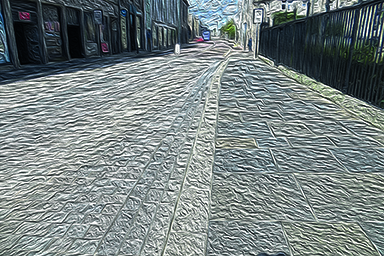Natural stone pavements have tangible benefits. Here’s an extract of an architect’s viewpoint on using natural stone when designing pavements:
The treatment of the surface of streets and squares makes a huge impact on the identity of any town or city.
Since Georgian times natural stone has been a favoured material in successful cities of the UK, including the magnificent streets of London, The Crescent in Bath and the elegant cities of Edinburgh and Liverpool. It was chosen to express prosperity and create places of worth.
Today natural stone is still chosen by designers and clients for its aesthetic properties – its inherent good looks and natural beauty – and its ability to retain these looks in the long term.
Some stone appearance actually improves with age. By comparison, man made alternatives can start to lose their visual appeal and be in need of renewal much sooner, often long before they have lost their structural integrity.
The wide variety of natural colours and the natural variations in any stone allow the creation of unique solutions that enhance local distinctiveness.
Stone can be successfully used as a simple mono-colour or by mixing a rich pattern with different hues, either bright or muted. The permanence of the colour along with its ability to resist fading in sunlight is a great asset.
Designing with natural stone allows flexibility because it can be produced in any number of sizes and shapes. It is, therefore, easy to design a pavement compatible with standard street furniture, kerbs and drainage.
The stone can be cut to exacting tolerances, allowing the creation of intricate designs. A good example of this is the creation of the complex granite seating walls at Pier Head, Liverpool.
The design of the individual units was computer modelled and cutting schedules prepared in the UK. The stone was cut and dry assembled like a giant jigsaw puzzle before transporting to check on accurate buildability. On site, the construction went smoothly with only minor fitting in adjustments required.
The versatility of stone is favoured by craftsmen and stonemasons. For generations, natural stone has been used for masonry, traditional carving and etching. Now, with modern developments in both CAD and cutting techniques, designers can embrace other aspects of art in the landscape, including text and illustration as well as inlay with other materials such as stainless steel.
Stone also facilitates a high-quality finish to contrasting step nosings and co-ordinating tactile pavings needed to help with DDA (Disability Discrimination Act) compliance.
On steps and walls ribbing can be cut into the natural stone to provide a subtle but effective deterrent to skateboarders, avoiding the need for the metal studs that can detract from a project’s ideal.
The natural durability and inherent strength of good quality natural stone make it ideal for townscape work where long scheme life is important. But it is important to select good quality stone. CE marking should be used as assurance of both quality and performance.
Using an appropriate stone with inherently good skid and slip resistance in conjunction with appropriate construction techniques means the pavement can safely accommodate vehicular traffic as well as heavy pedestrian use.

